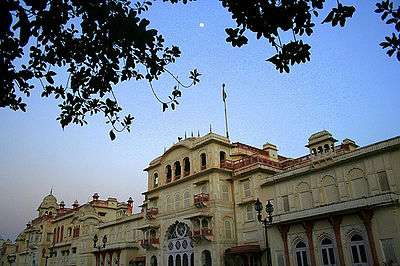Patiala
| Patiala ਪਟਿਆਲਾ | |
|---|---|
|
Moti Bagh Palace, Patiala now houses the National Institute of Sports | |
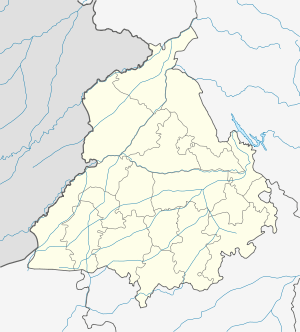 Patiala  Patiala | |
| Coordinates: 30°20′N 76°23′E / 30.34°N 76.38°ECoordinates: 30°20′N 76°23′E / 30.34°N 76.38°E | |
| Country |
|
| State | Punjab |
| District | Patiala |
| Settled | 1754 |
| Founded by | Guru Tegh Bahadur Ji |
| Named for | Baba Ala Singh |
| Government | |
| • Type | Democratic |
| • Body | Municipal Corporation of Patiala |
| • Deputy Commissioner | Ram vir singh |
| • Mayor | Amarinder Singh Bajaj |
| • Municipal Commissioner | Dr. Indu Malhotra |
| • Senior Superintendent of Police | Harpreet Singh |
| Area[1] | |
| • Total | 131.25 sq mi (339.9 km2) |
| Elevation[2] | 1,150 ft (350 m) |
| Population (2011) | |
| • Total | 446.246[3] |
| • Metro | 700,513 |
| Demonym(s) | Patialvi |
| Languages | |
| • Official | Punjabi |
| Time zone | IST (UTC+5:30) |
| PIN | 147001 |
| Telephone code | Patiala: 91-(0)175, Rajpura: 91-(0)1762, Patran & Samana: 91-(0)1764, Nabha: 91-(0)1765 & Amloh: 91-(0)1768 |
| ISO 3166 code | IN-Pb |
| Vehicle registration | PB-11 |
| Largest city | Patiala |
| HDI |
0.860 |
| HDI Category | very high |
| Literacy | 84.39% |
| Website |
patiala |
Patiala is a city in southeastern Punjab, in northern India. It is the fourth largest city in the state and is the administrative capital of Patiala district. Patiala is located around the Qila Mubarak (the Fortunate Castle). It was constructed by militiamen Sardar Lakhna and Baba Ala Singh in 1763.
In popular culture, the city remains famous for its traditional PatialaShahi turban (a type of headgear), paranda (a tasselled tag for braiding hair), patiala salwar (a type of female trousers), jutti (a type of footwear) and Patiala peg (a measure of liquor).[4]
Geography
Patiala is located at 30°19′N 76°24′E / 30.32°N 76.40°E.[5] It has an average elevation of 250 metres (820 feet). During the short existence of PEPSU, Patiala served as its capital city.
History
Patiala state was established in 1763 by Baba Ala Singh, a Jat Sikh chieftain, who laid the foundation of the Patiala fort known as Qila Mubarak, around 'which the present city of Patiala is built. After the Third Battle of Panipat in 1761 in which the Marathas were defeated by the Afghans, the writ of the Afghans prevailed throughout Punjab. It is at this stage that the rulers of Patiala began to acquire ensigns of royalty. The Patiala state saw more than forty years of ceaseless power struggle with the Afghan Durrani Empire, Maratha Empire and the Sikh Empire of Lahore. In 1808, the Raja of Patiala entered into a treaty with the British against Ranjit Singh of Lahore in 1808, thus becoming collaborator in the grand empire building process by the British in, the sub-continent of India. Patiala became a 17-guns salute state during the British Raj. The rulers of Patiala such as Karam Singh, Narinder Singh, Mahendra Singh, Rajinder Singh, Bhupinder Singh and Yadvindra Singh were treated with respect and dignity by the British.

The city of Patiala was designed and developed according to a plan akin to that of temple architecture, the first settlers of Patiala were the Hindus of Sirhind, who opened their business establishments outside the Darshani Gate.[6]
The royal house is now headed by His Highness Maharajadhiraj Captain Amarinder Singh, Mahendra Bahadur of Patiala who also served as the Chief Minister of Punjab from 2002 to 2007. The royals are considered cultural and political icons in Patiala.
Maharaja Karam Singh who ruled from 1813 to 1845 (the Sikh Kingdom of Patiala in Punjab) joined the British East India Company and helped the British during the First Anglo Sikh wars against the Sikh Empire of Maharajah Ranjit Singh of Punjab which was larger and extended from Tibet Kashmir, plains of Punjab to Peshawar near the Afghan borders.
Education
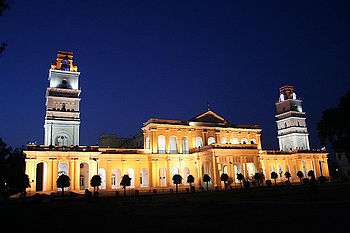
Since Indian independence in 1947, Patiala has emerged as a major education centre in the state of Punjab. The city houses the Thapar University,[7] Punjabi University,[8] Rajiv Gandhi National University of Law,[9] General Shivdev Singh Diwan Gurbachan Singh Khalsa College,[10] Mohindra College, Multani Mal Modi College, Rajindra Hospital, Government Medical College, Patiala, Government College for Girls, and Govt. Bikram College of Commerce,[11] one of the premier commerce colleges in northern India.
Netaji Subhash National Institute of Sports, Patiala is a sports hub of north India. Rajiv Gandhi National University of Law, Patiala[12] was the first national law school of north region established under Punjab Government Act of 2006.
Patiala city has many playgrounds, including the Raja Bhalindra Sports Complex, more commonly known as Polo Ground on Lower Mall Road, which houses an indoor stadium. Other sports facilities include Yadavindra Sports Stadium for athletics, Rink Hall for roller skating, Dhruv Pandov Cricket Stadium for cricket and National Institute of Sports, Patiala.
Tourist attractions
Gurdwara Dukh Niwaran Sahib

It is situated very close to Bus Stand, Patiala. According to local tradition, supported by an old handwritten document preserved in the Gurdwara, one Bhag Ram, a jhivar of Lehal, waited upon ninth guru of Sikhs Guru Tegh Bahadur during his sojourn at Saifabad (now Bahadurgarh), and made the request that he might be pleased to visit and bless his village so that its inhabitants could be rid of a serious and mysterious sickness which had been their bane for a long time. The Guru visited Lehal on Magh sudi 5, 1728 Bikram/24 January 1672 and stayed under a banyan tree by the side of a pond.[1] The sickness in the village subsided. The site where Guru Tegh Bahadur had sat came to be known as Dukh Nivaran, literally meaning eradicator of suffering. Devotees have faith in the healing qualities of water in the sarovar attached to the shrine. It is still believed that any kind of illness can be cured by 'ishnaan' on 5 consecutive panchmi
Gurdwara Moti Bagh Sahib
Gurudwara Moti Baag Sahib is situated in the Patiala City. When Shri Guru Teg Bahadur Sahib Ji started his journey towards Delhi, he came here via Kiratpur Sahib, Bharatgarh Sahib, Roap Makar, Kabulpur etc. Saint Saif Ali Khan was great follower of Guru Sahib, To fulfill his wish Guru Sahib came to his Place Saifabad (Bahadur Garh). Guru Sahib stayed here for 3 Months. Saif Ali Khan Served Guru Sahib with great Devotion. In daytime Guru Sahib used to meditate on the Place inside the Qila(Fort) and used to come here in the nighttime. From here Guru Sahib left towards Samana, Guru Sahib took rest for some time this place. From here Guru Sahib left towards Samana and stayed in the Haveli of Muhamad Bakhsish. From there onwards Guru Sahib left towards Cheeka Via Karhali, Balbera.
Bahadurgarh Fort
The Bahadurgarh Fort is 6 kilometres away from Patiala city. It is situated on the Patiala-Chandigarh road. The fort was constructed by Nawab Saif Khan in 1658 A.D and later renovated by a Sikh ruler Maharaja Karam Singh in 1837. The construction of the entire fort was completed in eight years. A sum of ten lakh rupees was spent on its construction. It covers an area of 2 km2. The fort is enclosed within two rounded walls and a moat. The circumference of the fort is slightly over two kilometres.
The name Bahadurgarh fort was given by Maharaja Karam Singh as a tribute to the Sikh Guru Teg Bahadur who stayed here for three months and nine days before leaving for Delhi. The fort consist of a historical Gurdwara Sahib (a Sikh temple) named Gurdwara Sahib Patshai Nauvin.This Gurudwara shows fine Sikh architecture. This gurudwara is controlled by the Shiromini Gurdwara Prabhandak Committee. People visit this gurdwara on the occasion of the festival of Baisakhi on 13 April, every year.
Maa Kali Devi Mandir

Shri Kali Devi Temple is a Hindu temple dedicated to Maa Kaali. The temple was built by the Sikh ruler of the Patiala State, Maharaja Bhupinder Singh, who financed the building of the temple in his capital and oversaw its installation in 1936. Bhupinder Singh ruled the princely state of Patiala from 1900 to 1938. He brought the 6-ft statue of Divine Mother Kali and Paawan Jyoti from Bengal to Patiala and offered the first Bali (sacrifice) of a water buffalo to the temple. Because of the temple’s beautiful structure, it has been declared a national monument. This large complex attracts devotees, Hindu and Sikh, from distant places. A much older temple of Raj Rajeshwari is also situated in the centre of this complex. The temple is situated opposite the Baradari garden at Mall Road. Devotees offer mustard oil, daal (lentils), sweets, coconuts, bangles and chunnis, goats, hens and liquor to the Divine Mother here. As an average estimate, devotees offer more than 60,000 liquor bottles during Navratras alone, which goes into a 'Sharab Kund' built on the temple's premises.[13]
Qila Mubarak complex

The Qila Mubarak complex stands on a 10-acre ground in the heart of the city and contains the main palace or Qila Androon (literally, 'inner fort'), the guesthouse or Ran Baas and the Darbar Hall. Outside the Qila are the Darshani Gate, a Shiva temple, and bazaar shops which border the streets that run around the Qila and sell precious ornaments, colourful hand-woven fabrics, 'jootis' and bright 'Parandis'.
It was the principal residence of the Patiala royals until the construction of Old Moti Bagh Palace.
The entrance is through an imposing gate. The architectural style of the palace is a synthesis of late Mughal and Rajasthani. The complex has 10 courtyards along the north-south axis. Each courtyard is unique in size and character, some being broad, others very small and others mere slits in the fabric of building. Though the Androon is a single interconnected building, it is spoken of as a series of palaces. Each set of rooms makes a cluster around a courtyard, and each carries a name: Topkhana, Qila Mubarak, Sheesh Mahal, Treasury and Prison. Ten of the rooms are painted with frescoes or decorated intricately with mirror and gilt.
In a tiny portion of the complex is a little British construction with Gothic arches, fireplaces made of marble and built-in toilets perched on the Mughal Rajasthani roof. Burj Baba Ala Singh has a fire smoldering ever since the time of Baba Ala Singh, along with a flame brought by him from Jwalaji. Every year its decorated beautifully for the Heritage Festival.
Sheesh Mahal

A part of the Old Moti Bagh Palace built in the 19th century by the Maharajas is the famous Sheesh Mahal, literally meaning the Palace of Mirrors. The mahal contains a large number of frescoes, most of which were made under His Highness Maharaja Narinder Singh. A lake in front of the palace adds to the beauty. Lakshman Jhula, a bridge built across the lake, is a famous attraction. A museum housing the largest collection of medals from the world collected by His Highness Maharaja Bhupinder Singh is here.
Currently the museum along with the main building is closed for public viewing because of renovation. However, tourists can access the surroundings of the Mahal along with the Lakshman Jhula.
Baradari Gardens

The Baradari Gardens are in the north of old Patiala city, just outside Sheranwala Gate. The garden complex, set up during the reign of Maharaja Rajindera Singh, has extensive vegetation of rare trees, shrubs, and flowers dotted with impressive Colonial buildings and a marble statue of Maharaja Rajindera Singh. It was built as a royal residence with a cricket stadium, a skating rink and a small palace set in its heart named Rajindera Kothi.
After extensive restoration it opened as a heritage hotel run by Neemrana Hotels group in 2009. It is Punjab's first heritage hotel. It is near Press Club Patiala. Press Club Patiala was established in 2006 and now headed by Parveen Komal, president.[14]
National Institute of Sports
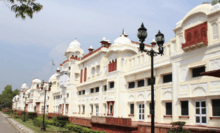
Founded in 1961, Netaji Subhas National Institute of Sports (NIS) is Asia's largest sports institute in princely city of Patiala. The institute was renamed as Netaji Subhas National Institute of Sports in January 1973.
NIS is housed in the Old Moti Bagh palace of erstwhile royal family of Patiala, which was purchased by government of India after Indian Independence. Today, several sport memorabilia, like a hass (doughnut shaped exercise disc), weighing 95 kg, used by the Great Gama for squats, Major Dhyan Chand's gold medal, from 1928 Amsterdam Olympics, and PT Usha 1986 Seoul Asiad shoes, are housed at the National Institute of Sports Museum.[15]
Sporting venues and gardens
Patiala is home to numerous inter-state sporting teams in tournaments like Black Elephants. The city has facilities for cricket, swimming, shooting, skating and hockey. The city has stadiums such as Dhruv Pandove Ground, Raja Bhalinder Stadium and National Institute of Sports.
The latest addition to sports is the state-of-the-art shotgun shooting ranges housing New Moti Bagh Gun Club at village Maine. Founded by the royal family of Patiala, these ranges are home to the Indian Shotgun Shooting team who routinely trains here. It has recently hosted the 2nd Asian Shotgun Championship.[16]
Governance
Patiala Municipal Corporation(PMC) is the local body responsible for governing, developing and managing the city. (PMC) is further divided into 50 municipal wards. Patiala Development Authority (PDA) is an agency responsible for planning and development of the greater Patiala Metropolitan Area, which is revising the Patiala Master Plan and Building Bylaws. Patiala Development Department, a special department of the Government of Punjab, has been recently formed for overall development.
Patiala consists of three assembly constituencies: Patiala Urban, Patiala Rural, Sanaur.
Demographics
As per provisional data of 2011 census Patiala City had a population of 446,246 comprising Patiala Metro had a population of 700,513. Males constituted 54% of the population, and females 46%. Patiala had an average literacy rate of 81%, higher than the national average of 64.9%. In Patiala, 10% of the population was under 5 years of age.
Culture and traditions
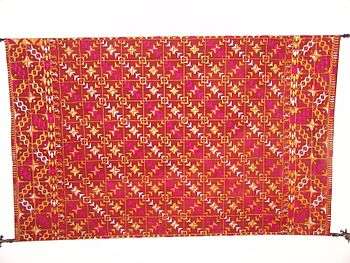
Patiala's sway over the Malwa area extended beyond merely political influence. Patiala was equally the set of religious and cultural life. Educationally, Patiala was in the forefront. Patiala was the first town in this part of the country to have a degree college – the Mohindra College – in 1870.
Patiala has seen the evolution of a distinct style of architecture. Borrowing from the Rajput style, its beauty and elegance are moulded according to the local traditions.

With the active patronage of the Maharajas of Patiala, a well-established style of Hindustani music called the "Patiala Gharana" came into existence and has held its own up to the present times. This school of music has had a number of famous musicians, many of whom came to Patiala after the disintegration of the Mughal Court at Delhi in the 18th century. At the turn of the century, Ustad Ali Bux was the most renowned exponent of this Gharana. Later, his sons Ustad Akhtar Hussain Khan and Ustad Bade Ghulam Ali Khan achieved worldwide fame and brought glory to the Patiala Gharana.
After partition of British India, Muslims were forced to flee the city en masses to Pakistan, while many Hindu and Sikh refugees migrated from Pakistan and settled on the Muslim properties in Patiala. The then Maharaja of Patiala, His Highness Yadavindra Singh, Rajpramukh of PEPSU with his wife Her Highness Maharani Mohinder Kaur organised a large number of camps and worked tirelessly for the people.
District administration
The Deputy Commissioner, an officer belonging to the Indian Administrative Service, is the overall in-charge of the General Administration in the district. He is assisted by a number of officers belonging to Punjab Civil Service and other Punjab state services.
The brand-new Mini Secretariat on Nabha Road, which houses all the major offices including that of the DC and the SSP, was completed in record time, owing to the initiative of the member of parliament of Patiala and local administration.
In India, an Inspector General (IG) of Police is a two-star rank of the Indian Police Service. The ranks above this are Additional Director General (Addl.DG) and Director General (DG) of police. In Patiala, joint commissioner's are at the rank of DIG and only additional commissioner's are at the rank of IG.
The Senior Superintendent of Police, an officer belonging to the Indian Police Service, is responsible for maintaining law and order and related issues in the district. He is assisted by the officers of the Punjab Police Service and other Punjab Police officials.
The Divisional Forest Officer, an officer belonging to the Indian Forest Service, is responsible for the management of the Forests, Environment and Wild-Life in the district. He is assisted by the officers of the Punjab Forest Service and other Punjab Forest officials and Punjab Wild-Life officials.
Sectoral development is looked after by the district head officer of each development department such as PWD, Health, Education, Agriculture, Animal husbandry, etc. These officers are from Punjab state services.
Transport
Patiala has one of the highest number of vehicles per capita in India.[18]
It is connected to cities like Ambala, Chandigarh, Amritsar, Delhi etc. by road. Patiala is well connected to cities like Ludhiana, Jalandhar and Amritsar, on NH 1 via State Highway no. 8 till Sirhind, which is on NH 1. Patiala is well connected to Delhi by road as well as by rail. NH 64 (Zirakpur – Patiala – Sangrur – Bhatinda) connects Patiala with Rajpura (on NH 1 and very well connected to Delhi) and Zirakpur(suburb of Chandigarh). Patiala has a railway station under Ambala railway division and Patiala Airport, which is not operational. The nearest domestic airport is Chandigarh Airport, which is approximately 62 km from the city.
Patiala is connected by road to all the major towns.
Distance between the major towns and Patiala:
- Ambala - 51 km
- Zirakpur - 58 km
- Chandigarh – 67 km
- Ludhiana – 93 km
- Jalandhar – 155 km
- Bathinda - 156 km
- Shimla – 173 km
- Delhi – 233 km
- Amritsar – 235 km
- Agra – 437 km
- Jaipur – 454 km
- Lucknow – 669 km
- Mumbai – 1627 km
- Kolkata – 1637 km
Entertainment
The city has following single screen cinema halls: Phul, Malwa, Capital. SRS Omaxe mall is a local mall and multiplex.
Notable people
| Name | Occupation | |
|---|---|---|
| Mahendra Singh of Patiala | Maharaja of Princely State Patiala | |
| Maharaja Rajinder Singh | Maharaja of Princely State Patiala | |
| Bhupinder Singh | Grandfather of Captain Amarinder Singh and Maharaja of Princely State Patiala | |
| Yadavindra Singh | Father of Captain Amarinder Singh and Cricketer | |
| Mohinder Kaur | Rajmata of Patiala and Mother of Captain Amarinder Singh | |
| Captain Amarinder Singh | 29th Chief Minister of Punjab | |
| Preneet Kaur | MP & Minister of State for External Affairs (Central Govt. under PM Manmohan Singh) | |
| Bibi Amtus Salam | Social Worker | |
| Pawan Kumar Bansal | four times MP, Union Minister of India (twice) | |
| Surjit Singh Rakhra | Member of Legislative Assembly | |
| Dalip Kaur Tiwana | Punjabi writer | |
| Damandeep Singh Baggan | Dub-over Voice Actor | |
| Roopinder Singh | Asst Editor, The Tribune & a writer | |
| Harpal Tiwana | Actor, writer and director | |
| Abhinav Bindra | the first Indian to win an individual gold medal at the Olympics | |
| Gul Panag | Actor | |
| Gugu Gill | Actor | |
| Samiksha | Actor | |
| Smeep Kang | Actor, writer and director | |
| Raninder Singh | President National Rifle Association of India (NRAI) | |
| Bhupinder Singh (musician) | Singer and musician | |
| Madan Puri | Actor | |
| Amrish Puri | Actor | |
| Om Puri | Actor | |
| Jimmy Shergill | Actor | |
| Binnu Dhillon | Actor | |
| Gulzar Inder Chahal | Actor and Cricketer | |
| Gavie Chahal | Actor | |
| Rakesh Sharma | The first Indian astronaut.[19][20] | |
| Satwinder Bitti | Famous female Punjabi singer | |
| Harbhajan Mann | Punjabi singer and actor | |
| Mika Singh | Punjabi singer and actor | |
| Dilshad Khan | husband of Parveen Sultana, Member of Patiala Gharana and Singer | |
| Fateh Ali Khan | Member of Patiala Gharana and Singer | |
| Hamid Ali Khan | Member of Patiala Gharana and Singer | |
| Jagdish Prasad | Member of Patiala Gharana and Singer | |
| Johar Ali Khan | Member of Patiala Gharana and Singer | |
| Kaushiki Chakraborty | daughter of Ajoy Chakraborty, Member of Patiala Gharana and Singer | |
| Lakshmi Shankar | Member of Patiala Gharana and Singer | |
| Munawar Ali Khan | son of Bade Ghulam Ali Khan, Member of Patiala Gharana and Singer | |
| Nirmala Devi | Member of Patiala Gharana and Singer | |
| Parveen Sultana | Member of Patiala Gharana and Singer | |
| Raza Ali Khan | grandson of Bade Ghulam Ali Khan, Member of Patiala Gharana and Singer | |
| Sanjukta Ghosh | Member of Patiala Gharana and Singer | |
| Shafqat Amanat Ali | Member of Patiala Gharana and Singer | |
| Mohammad Hussain Sarahang from Afghanistan | Member of Patiala Gharana and Singer | |
| Daler Mehndi | Punjabi singer | |
| Pammi Bai | Punjabi Singer | |
| Malkit Singh | Punjabi Singer | |
| Vinaypal Buttar | Punjabi Singer | |
| Navjot Singh Sidhu | Former cricketer, actor, commentator and politician | |
| Mohinder Amarnath | Cricketer | |
| Sandeep Sharma | Cricketer | |
| Sarabjit Ladda | Cricketer | |
| Inderbir Singh Sodhi | Cricketer | |
| Anmolpreet Singh | Cricketer | |
| Ravi Inder Singh | Cricketer | |
| Jiwanjot Singh | Cricketer | |
| Deepak Thakur | Hockey Player | |
| Heena Sidhu | Shooter | |
| Kamal Khan (singer) | Singer | |
| Navneet Kaur Dhillon | Femina Miss India 2013 |
Suburbs In Patiala
Nabha (Municipal Council) 25 km
Rajpura (Municipal Council) 27 km
Samana (Municipal Council) 27 km
See also
- Patiala and East Punjab States Union
- Chandigarh
- Mohali
- Panchkula
- Rajpura
- Fatehgarh Sahib
- Mandi Gobindgarh
References
- ↑ "US Gazetteer files: 2010, 2000, and 1990". United States Census Bureau. 12 February 2011. Retrieved 23 April 2011.
- ↑ "US Board on Geographic Names". United States Geological Survey. 25 October 2007. Retrieved 31 January 2008.
- ↑ "Patiala Urban Region". Census 2011. Retrieved 8 April 2016.
- ↑ "History of Patiala". Official Website of District Patiala. Retrieved 19 August 2011.
- ↑ "Falling Rain Genomics, Inc – Patiala".
- ↑ "History Of Patiala".
- ↑ "Thapar Institute of Engineering and Technology University - Home".
- ↑ "University Punjabi – Established under Punjab Act No.35 of 1961".
- ↑ "ワンランク上の風俗嬢".
- ↑ "Welcome to Khalsa College Patiala".
- ↑ "home".
- ↑ rgnulpatilala.org
- ↑ http://www.hdfcbank.com/personal/donate-online/religious-offering-inner/1323430251
- ↑ "Fort right". The Tribune. 6 August 2009.
- ↑ NIS
- ↑ http://thenrai.in/index.php?option=com_content&view=article&id=323
- ↑ "Patiala District Religion Data - Census 2011".
- ↑ "Top Ten Towns with Highest Number of Car Ownership in India".
- ↑ "U.S. and Russian Human Spaceflights, 1961-Sep. 30, 1995". NASA. Retrieved 19 August 2011.
- ↑ "Biographies of International Astronauts". SpaceFacts. Retrieved 19 August 2011.
External links
| Wikimedia Commons has media related to Patiala. |
| Wikisource has the text of the 1911 Encyclopædia Britannica article Patiala. |
-
 Patiala travel guide from Wikivoyage
Patiala travel guide from Wikivoyage - Official Website of Patiala
- Official Website of Media
